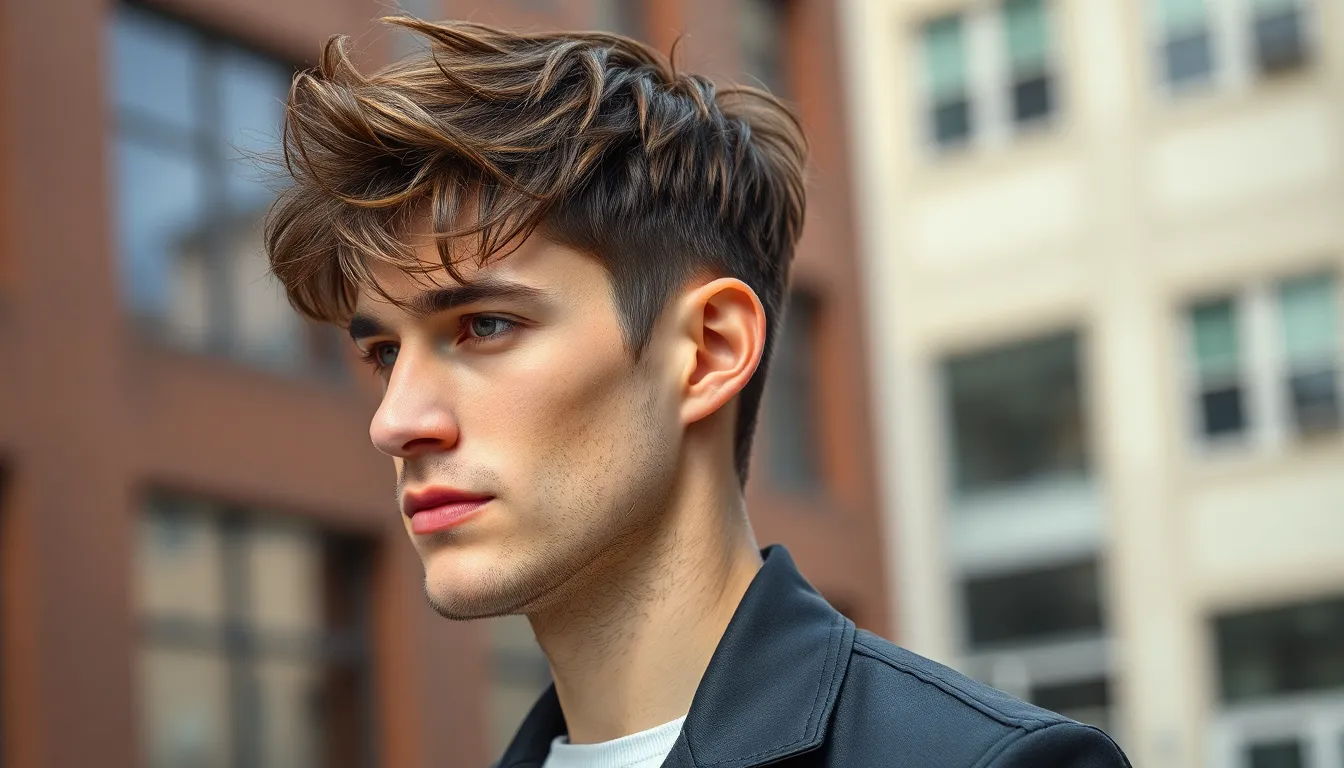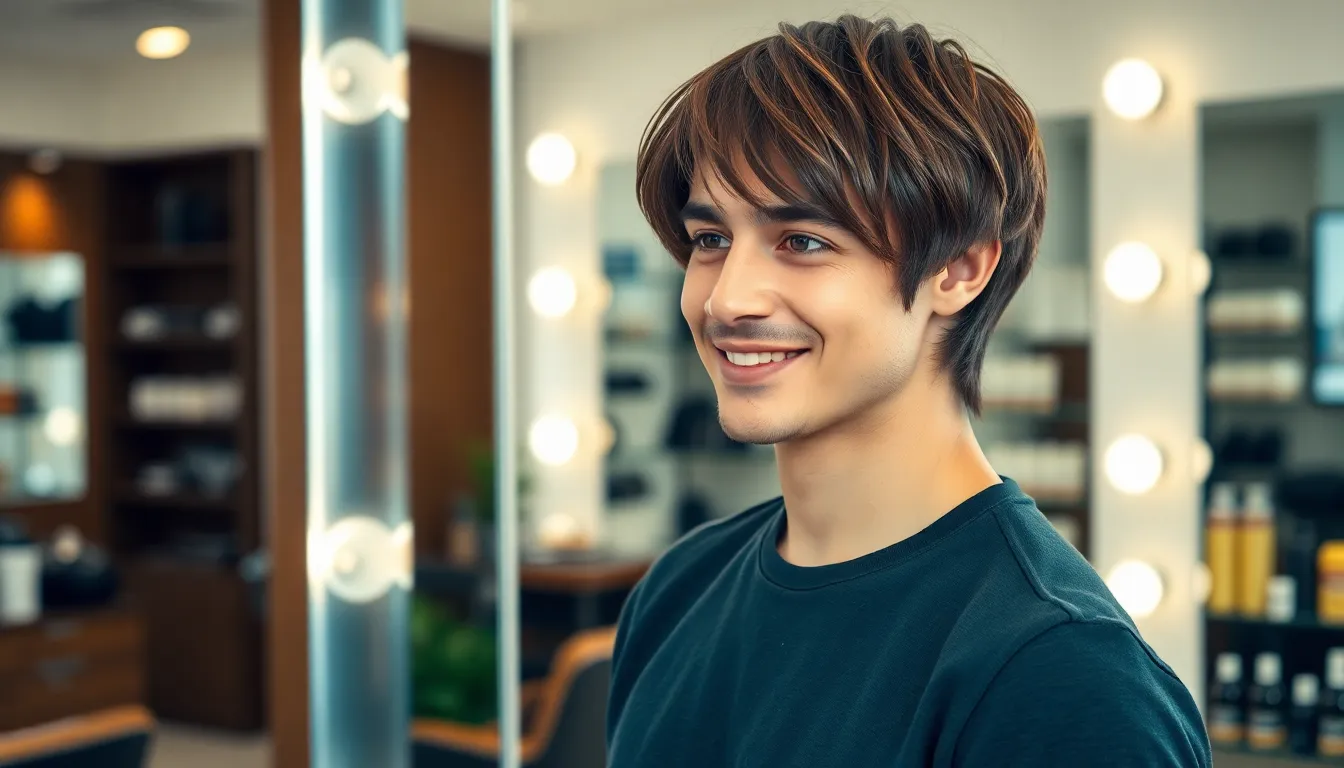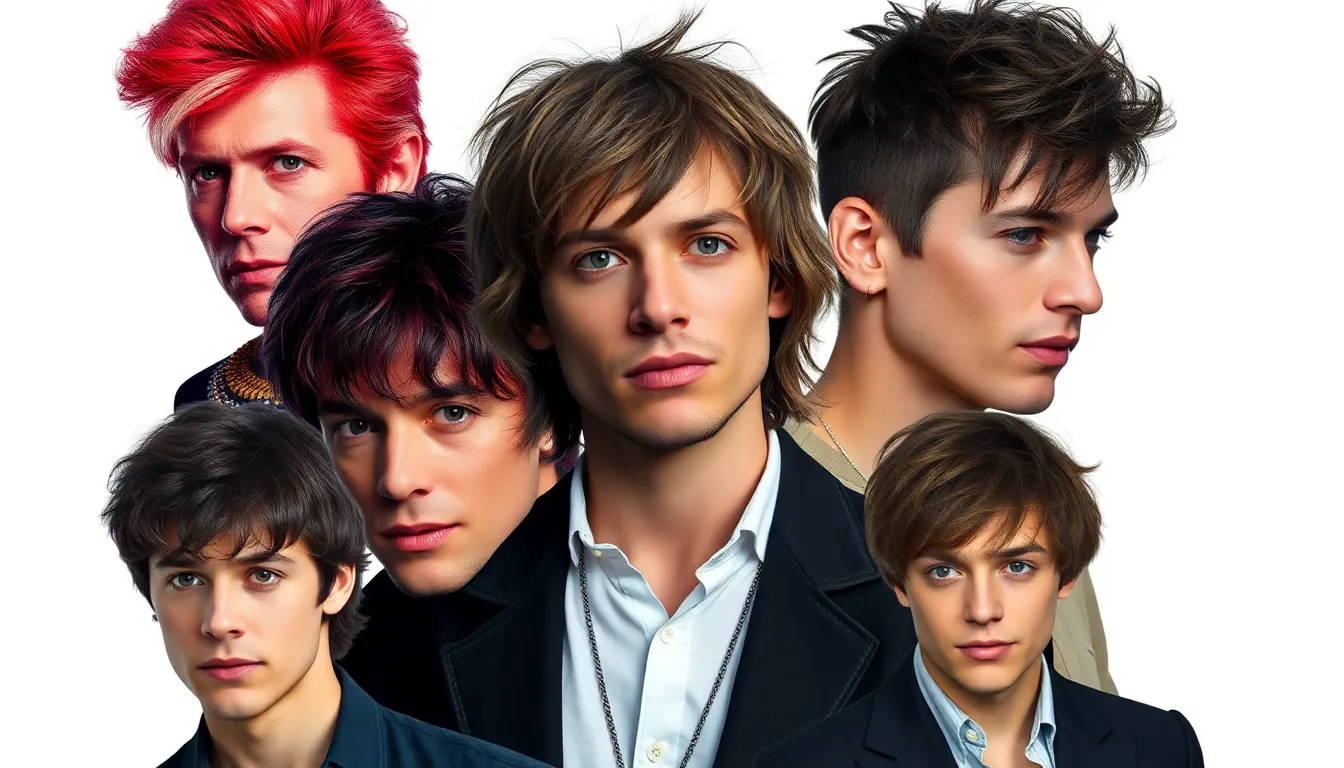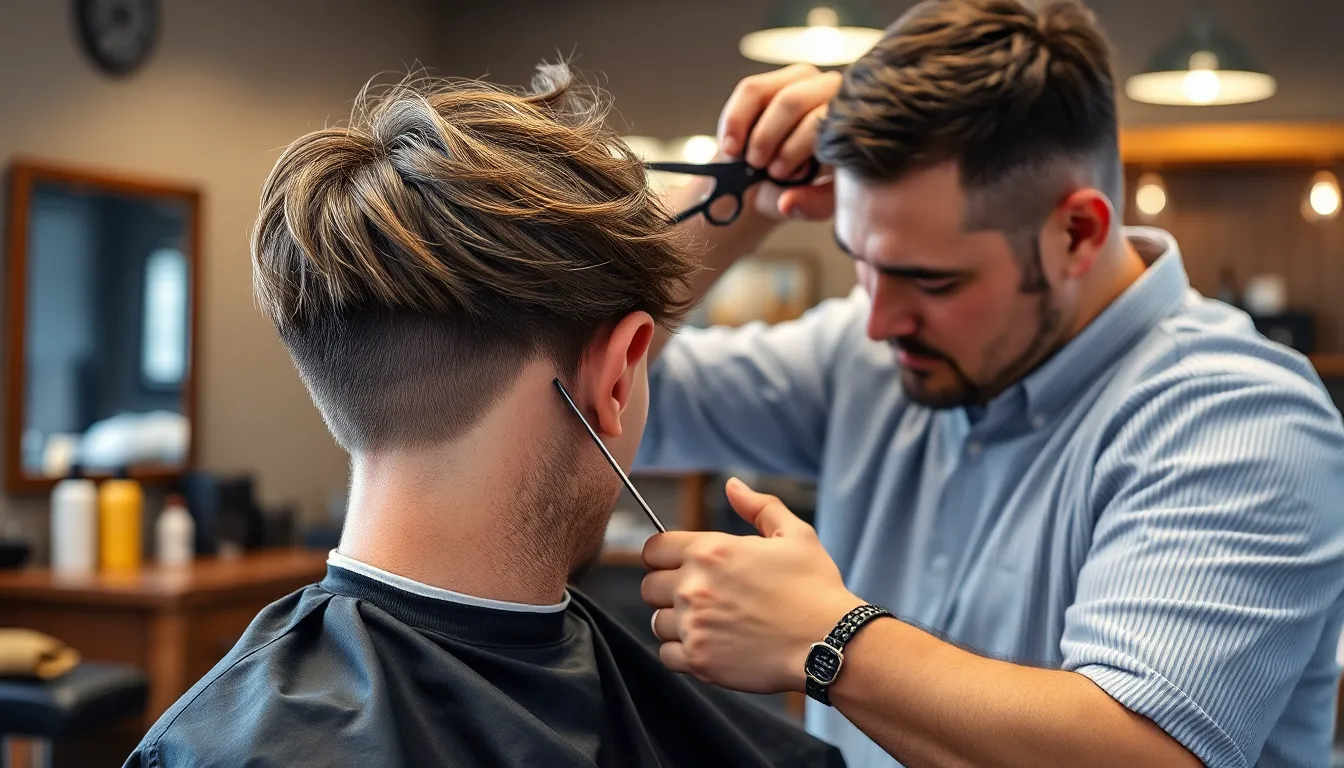The shag haircut has made a major comeback and we’re seeing men everywhere embrace this effortlessly cool style. What started as a rock-and-roll statement in the 1970s has evolved into one of today’s most versatile and sought-after men’s hairstyles. From subtle textured layers to bold choppy cuts the modern shag offers something for every guy looking to add movement and personality to their look.
We’ve watched this trend explode across social media and barbershops alike as men discover how flattering a well-executed shag can be. The beauty lies in its adaptability – whether you’ve got straight hair wavy locks or even curly textures there’s a shag variation that’ll work perfectly with your natural hair type and face shape.
Ready to transform your hair game? We’re breaking down everything you need to know about men’s shag haircuts including the best styles current trends and expert tips to help you rock this iconic look with confidence.
What Is a Shag Haircut for Men
A men’s shag haircut combines multiple layered lengths with textured, feathered ends to create volume and movement throughout the hair. We define this versatile style as a deliberately tousled look that works across different hair types and face shapes.
Origins and History of the Shag Cut
Rock musicians in the 1970s popularized the original shag haircut as their signature rebellious style. David Bowie and Rod Stewart showcased dramatic shag cuts that featured heavy layering and wild texture during their iconic performances. British hairstylist Paul McGregor created the foundational shag technique that emphasized choppy layers and deliberate asymmetry.
Women initially dominated shag popularity through stars like Jane Fonda and Farrah Fawcett in the mid 1970s. Male celebrities began adopting modified shag variations throughout the late 1970s and early 1980s. Musicians like Keith Richards and Mick Jagger transformed the shag into a masculine statement that represented creative freedom and artistic expression.
Fashion trends shifted away from shags during the 1990s as sleeker styles gained prominence. Contemporary barbers revived men’s shag cuts in the 2010s by incorporating modern cutting techniques and styling products. Social media platforms like Instagram and TikTok accelerated the shag’s return to mainstream popularity among younger generations.
Key Characteristics of Men’s Shag Hairstyles
Layered cutting techniques create the foundation of every men’s shag haircut through varied lengths throughout the head. Choppy ends define the shag’s signature texture while preventing the hair from appearing too uniform or structured. Feathered pieces around the face soften harsh angles and create natural movement when styled properly.
Essential Shag Elements:
| Characteristic | Description | Style Impact |
|---|---|---|
| Multiple layers | 3-5 distinct length variations | Creates volume and dimension |
| Textured ends | Razor or point cutting technique | Adds natural movement |
| Face framing pieces | Longer sections near temples | Softens facial features |
| Crown volume | Shorter layers on top | Provides lift and body |
| Graduated lengths | Progressive layer transitions | Ensures seamless blending |
Volume concentration occurs primarily in the crown and mid lengths rather than the ends of the hair. Thinning shears remove bulk while maintaining the shag’s characteristic fullness and bounce. Professional stylists use razors to create the soft, wispy texture that distinguishes shags from traditional layered cuts.
Modern shag variations incorporate undercuts or faded sides to create contemporary contrast with the layered top section. Styling products like sea salt spray and texturizing mousse enhance the natural movement and separation between layers.
Best Face Shapes for Men’s Shag Haircuts

Understanding how different face shapes complement shag haircuts helps you choose the most flattering variation. We’ll explore which facial structures work best with this versatile layered style.
Oval and Round Face Shape Compatibility
Oval faces represent the ideal canvas for men’s shag haircuts since their balanced proportions work with virtually any layered style. The natural symmetry allows for creative freedom with length, texture, and volume placement throughout the hair.
Men with oval face shapes can experiment with longer shag variations that extend past the ears or shorter choppy styles that emphasize the crown area. Side-swept bangs create additional dimension while maintaining the face’s natural harmony.
Round faces benefit tremendously from shag haircuts that add height and reduce width perception. Layered styles with volume at the top and tapered sides help elongate the appearance of rounder facial structures.
Strategic layering around the crown area creates vertical lines that draw attention upward. We recommend avoiding excessive volume at the sides, which can make round faces appear wider than desired.
Square and Heart-Shaped Face Considerations
Square face shapes require shag haircuts that soften angular jawlines and prominent cheekbones. Longer layers that frame the face help balance strong geometric features with flowing, textured movement.
The key lies in creating volume above the temples while allowing hair to fall naturally around the jaw area. Choppy layers work particularly well for square faces when they’re styled to curve inward rather than flare outward.
Heart-shaped faces excel with shag haircuts that add width at the jawline and chin area. Longer layers concentrated in the lower sections help balance narrow chins with broader foreheads.
Men with heart-shaped faces should focus on creating fullness around the ears and neckline. Side parts work exceptionally well for this face shape, directing hair toward the narrower portion of the face for optimal proportion.
Popular Types of Shag Haircuts for Men

We’ve identified three distinct categories of men’s shag haircuts that consistently deliver impressive results across different hair types and personal styles.
Classic Long Shag Styles
Classic Long Shag Styles recreate the iconic 1970s rock star aesthetic with layers that extend past the shoulders. Musicians like Steven Tyler and Robert Plant popularized this dramatic interpretation of men’s shag cuts during the decade’s peak music era. Layers begin around the crown area and cascade down to create natural movement throughout longer hair lengths.
Feathered long shags incorporate soft, sweeping layers that frame the face while maintaining substantial length in the back. Stylists typically cut these variations with razor techniques to achieve the signature wispy texture that defines classic shag haircuts. Hair naturally falls away from the face to create an effortless, windblown appearance that works particularly well for men with straight to wavy hair textures.
Bohemian inspired long shags blend multiple layer lengths to create an artistic, free spirited look that appeals to creative professionals. Barbers often leave the perimeter length intact while adding internal layers for movement and volume. This variation requires minimal styling products and embraces the natural texture of each hair type.
Modern Short Shag Variations
Contemporary short shag cuts adapt traditional layering techniques to work with shorter hair lengths ranging from 2 to 4 inches. Modern barbers integrate undercut elements or fade techniques around the sides while maintaining the characteristic choppy layers on top. These variations suit professional environments while still delivering the edgy aesthetic that makes shag haircuts appealing.
Disconnected short shags create contrast by keeping the top section longer with dramatic layering while cutting the sides much shorter. Stylists typically use texturizing shears to achieve the choppy, piece-y finish that defines this modern interpretation. The result produces a more structured appearance compared to traditional shag styles.
Tousled short shag styles emphasize natural texture through strategic layering that encourages hair to fall in different directions. Barbers cut these variations with point cutting techniques to create soft, irregular edges throughout the hair. Sea salt spray or light texturizing creams enhance the deliberately messy finish that characterizes this popular variation.
Textured Medium Length Shag Cuts
Medium length textured shags offer the perfect balance between manageability and the full shag effect with hair lengths between 4 to 6 inches. These cuts incorporate graduated layers that start shorter near the crown and progressively lengthen toward the ends. The medium length allows for versatile styling options while maintaining the signature movement that defines quality shag haircuts.
Layered shag cuts for medium length hair focus on creating distinct separation between different hair sections through precise cutting angles. Professional stylists use slide cutting techniques to blend multiple layer lengths seamlessly while preserving the textured, uneven finish. This approach works exceptionally well for men with thick or coarse hair types that need weight removal.
Wavy medium shags enhance natural curl patterns through strategic layering that reduces bulk while encouraging wave formation. Barbers cut these styles to work with existing hair texture rather than against it. The layers help distribute weight evenly to prevent the triangular shape that often occurs with wavy hair when cut in traditional styles.
How to Style Men’s Shag Haircuts

Styling men’s shag haircuts requires the right combination of products and techniques to enhance the natural layers and texture. We’ll guide you through the essential steps to achieve that perfect tousled look while maintaining the style’s characteristic movement and volume.
Essential Hair Products for Shag Styling
Texturizing spray creates the foundation for any successful shag style. Apply this lightweight product to damp hair before blow drying to enhance natural texture and add grip to your layers. Sea salt spray works particularly well for creating that effortless beachy texture that complements longer shag variations.
Volumizing mousse lifts hair at the roots and adds body throughout the layers. Work a golf ball sized amount through wet hair from roots to ends, focusing on the crown area where shag cuts typically need the most volume. This product helps maintain lift without weighing down the feathered ends.
Matte paste provides flexible hold while preserving the shag’s natural movement. Unlike heavy gels or pomades, matte paste allows you to piece out individual layers and create separation without stiffness. We recommend using it sparingly on dry hair to define exact sections and add subtle texture.
Heat protectant spray shields your hair from styling tool damage. Since shag cuts often require blow drying and occasional use of diffusers or curling tools, this protection becomes essential for maintaining healthy hair texture. Apply it evenly before any heat styling to prevent dryness and breakage.
Daily Styling Techniques and Tips
Start with towel dried hair that’s about 70% dry for optimal styling results. Gently squeeze excess moisture from your hair using a microfiber towel, avoiding aggressive rubbing that can disrupt the natural curl pattern and create frizz. This moisture level provides the perfect base for product application.
Scrunch styling products upward from ends to roots using your hands. This technique enhances the shag’s natural layers while encouraging curl formation and texture development. Work in small sections to ensure even product distribution throughout all the layered lengths.
Blow dry using a diffuser attachment on low heat and speed settings. Position the diffuser close to your scalp and lift sections of hair into the bowl, allowing the gentle airflow to dry your hair without disturbing its natural texture. This method preserves the shag’s characteristic volume and prevents flattening.
Flip your hair upside down during the final stages of drying. This gravity defying technique adds extra volume at the roots and creates lift throughout the crown area. Finish with a blast of cool air to set the style and add shine to your completed look.
Use your fingers to separate and define individual layers once hair is completely dry. Avoid brushes or combs which can flatten the texture and remove the carefully created volume. Instead, gently rake your fingers through exact sections to enhance the choppy, lived in appearance.
Creating Volume and Texture
Root lifting begins during the washing process with proper shampooing technique. Focus cleansing efforts on your scalp rather than the lengths of your hair, which helps maintain natural oils that enhance texture. Use lukewarm water to avoid stripping essential moisture from your layered ends.
Strategic sectioning during styling maximizes volume potential throughout your shag cut. Divide your hair into three horizontal sections: bottom, middle, and top layers. Style each section individually, lifting hair away from your head while blow drying to create maximum lift and separation.
Twist individual sections while they’re still slightly damp to encourage natural texture. This technique works especially well for medium length shag cuts, as it helps define the layers and creates interesting movement patterns. Release the twists once hair is about 80% dry for the best results.
Cold air blasts from your blow dryer seal the hair cuticle and lock in volume. After completing your styling routine with warm air, switch to the cool setting and direct airflow over your entire head. This final step adds shine and helps your shag style last longer throughout the day.
Avoid over manipulation once your style is set. Resist the urge to constantly run your fingers through your hair, as this can flatten carefully created volume and disrupt the texture. Instead, make minor adjustments only when necessary to maintain the shag’s effortless appearance.
Maintenance Requirements for Men’s Shag Hairstyles

Keeping your shag haircut looking fresh requires consistent care and proper maintenance techniques. We’ll guide you through the essential upkeep strategies that preserve your shag’s signature layers and texture.
Recommended Trimming Schedule
Professional touch-ups every 4 to 6 weeks maintain the shag’s distinctive layered structure and prevent overgrowth. Scheduling regular appointments with your barber ensures the layers remain balanced and the textured ends stay crisp. We recommend booking your next trim before leaving the salon to maintain consistency in your haircut’s shape.
Longer shag variations require trims every 6 to 8 weeks since the extended length allows more flexibility between appointments. Observing your hair’s growth pattern helps determine the optimal timing for maintenance cuts. We notice that men with faster-growing hair need appointments closer to the 4-week mark to prevent the style from losing its definition.
Split ends and damaged tips compromise the shag’s feathered appearance and should be addressed immediately. Trimming these damaged areas between regular appointments preserves the overall health of your hairstyle. We suggest using sharp scissors for any emergency touch-ups to avoid creating additional split ends.
At-Home Care and Washing Routine
Washing your shag every 2 to 3 days maintains natural oils while keeping the layers clean and manageable. Using lukewarm water prevents damage to the hair cuticles and maintains the textured finish of your cut. We recommend focusing shampoo application on the scalp rather than the lengths to avoid stripping natural moisture.
Conditioner application should concentrate on the mid-lengths and ends where the layered sections need the most hydration. Avoiding the roots prevents weighing down the volume that makes shag haircuts so distinctive. We suggest using a wide-tooth comb to distribute conditioner evenly through the layers without disrupting the natural texture.
Deep conditioning treatments once weekly restore moisture to heavily layered areas that experience more styling manipulation. Choosing protein-free formulas prevents buildup while maintaining the hair’s natural movement and bounce. We apply these treatments primarily to the longest layers where damage typically occurs first.
Air-drying whenever possible preserves the shag’s natural texture and reduces heat damage to the delicate layered ends. Gently squeezing excess water with a microfiber towel minimizes frizz and maintains the cut’s intended shape. We recommend avoiding aggressive rubbing that can disrupt the carefully crafted layers and create unwanted volume in the wrong areas.
Celebrity Inspiration for Men’s Shag Cuts

Drawing inspiration from celebrities can help you visualize how different shag variations translate into real-industry style success. We’ve compiled the most influential celebrity examples that showcase the versatility and appeal of men’s shag haircuts.
Rock Star Shag Influences
David Bowie pioneered the men’s shag movement with his iconic Ziggy Stardust era haircut that featured dramatic layers and feathered texture. His copper-colored shag became a cultural phenomenon, proving that men could embrace voluminous, textured styles with confidence and artistic flair.
Mick Jagger popularized the longer shag variation throughout the 1970s, sporting shoulder-length layers that moved dynamically during performances. His natural brown shag demonstrated how this haircut enhanced facial features while maintaining an effortlessly cool rock star aesthetic.
Keith Richards showcased the lived-in shag approach, letting his layered cut grow naturally between trims to create that authentic, weathered rock musician look. His styling approach emphasized the shag’s low-maintenance appeal while still delivering maximum visual impact.
Rod Stewart became synonymous with the voluminous shag style, using backcombing techniques to amplify his natural texture and create signature height. His platinum blonde shag proved that color treatments could enhance the dramatic effect of layered cutting techniques.
Modern Celebrity Shag Examples
Timothée Chalamet has modernized the shag for younger generations, sporting a medium-length version with subtle layers that frame his facial structure perfectly. His approach demonstrates how contemporary shag cuts can look sophisticated and age-appropriate for professional settings.
Cole Sprouse embraces the textured medium shag with natural wave patterns that create effortless movement and dimension. His styling routine focuses on improving natural texture rather than fighting against it, making his shag appear authentically tousled.
Matthew McConaughey proves that shag cuts work beautifully on mature men, using longer layers to soften facial lines while maintaining a masculine edge. His sun-bleached shag showcases how this haircut ages gracefully with proper maintenance and styling.
Harry Styles has experimented with various shag lengths, from shoulder-grazing styles to shorter interpretations that incorporate modern cutting techniques. His willingness to evolve his shag demonstrates the haircut’s adaptability across different fashion phases and personal style preferences.
Choosing the Right Barber for Your Shag Haircut

Finding a skilled professional who understands men’s shag techniques makes the difference between a modern rock star look and a dated disaster. We need barbers who’ve mastered layered cutting methods and understand how textured styles work with different hair types.
Questions to Ask Your Stylist
Experience with layered cuts should be your first inquiry when consulting potential barbers. Ask how many men’s shag haircuts they complete monthly to gauge their familiarity with these textured styles. Request to see before-and-after photos of their shag work, specifically examples that match your hair type and desired length.
Cutting technique knowledge reveals whether your stylist understands proper shag methods. Inquire about their approach to creating graduated layers and how they achieve the signature feathered ends. Ask which cutting techniques they prefer for different hair textures, particularly if you have naturally curly or fine hair.
Product recommendations from your barber indicate their commitment to your style’s success. Question which texturizing products they suggest for your exact shag variation and how often you’ll need professional maintenance. Request their advice on daily styling routines that work best with your face shape and lifestyle.
Timeline expectations help you plan for the transformation process. Ask how long the initial cut will take and whether achieving your desired shag look requires multiple sessions. Clarify the recommended interval between touch-up appointments to maintain your haircut’s structure.
Finding Shag Experienced Professionals
Research local barbershops that specialize in modern men’s cuts rather than traditional short styles. We recommend checking online portfolios and social media accounts where skilled barbers showcase their layered cutting work. Look for establishments that regularly post men’s textured hairstyles and demonstrate knowledge of current shag trends.
Read client reviews that specifically mention layered cuts, textured styles, or rock inspired haircuts. Search for testimonials from customers who’ve received shag variations similar to what you’re considering. Pay attention to comments about barbers who understand how to work with different hair textures and face shapes.
Schedule consultations with multiple professionals before committing to your shag transformation. We suggest booking brief meetings where you can discuss your vision, examine their previous shag work, and assess their understanding of layered cutting techniques. Use these sessions to evaluate communication skills and determine which barber best understands your style goals.
Verify credentials by asking about formal training in advanced cutting techniques or specialized education in textured styles. Look for barbers who’ve attended workshops focusing on modern men’s hairstyles or those certified in exact layering methods. Consider professionals who regularly update their skills through continuing education programs.
Common Mistakes to Avoid with Men’s Shag Haircuts

Making certain mistakes with shag haircuts can transform this stylish look into a disappointing mess. We’ve identified the most critical errors that prevent men from achieving the perfect textured, voluminous shag style.
Styling Errors That Flatten the Look
Over-brushing destroys the natural texture that makes shag cuts so appealing. We see too many men using regular brushes or fine-tooth combs on their styled shag, which separates the carefully crafted layers and eliminates the desired tousled effect. Instead, use your fingers or a wide-tooth comb to gently shape the hair while it’s damp.
Using heavy styling products weighs down the layers and creates a greasy, flat appearance. Products like heavy pomades, thick gels, or oil-based creams coat each strand and prevent the natural movement that defines a great shag. Stick to lightweight texturizing sprays, volumizing mousses, or matte pastes that enhance rather than suppress your hair’s natural body.
Blow-drying with too much heat flattens the root volume and damages the delicate layered ends. We recommend using a diffuser attachment on low heat settings or allowing your hair to air dry naturally. High heat settings break down the hair’s natural texture and can make even the best shag cut look lifeless and overdone.
Applying products to wet hair dilutes their effectiveness and can create uneven distribution throughout the layers. Always apply styling products to damp hair that’s been gently towel-dried first. This technique ensures better product absorption and helps maintain the shag’s signature choppy texture.
Styling against your natural growth pattern fights your hair’s inherent direction and creates an unnatural, forced appearance. Work with your cowlicks and natural hair flow rather than trying to force your shag into an unnatural shape that won’t hold throughout the day.
Maintenance Mistakes That Ruin the Cut
Waiting too long between trims destroys the shag’s carefully balanced proportions. We’ve seen perfectly executed shag cuts turn into shapeless, overgrown messes when clients stretch appointments beyond 6 to 8 weeks. Regular maintenance keeps the layers defined and prevents the bottom sections from becoming too heavy and dragging down the overall silhouette.
Cutting the layers yourself or visiting inexperienced barbers ruins the intricate layering technique that professional shag cuts require. DIY trimming typically results in uneven lengths, choppy sections that weren’t intended, and destroyed face-framing pieces. Always return to a qualified stylist who understands the exact cutting angles and graduation patterns that create authentic shag texture.
Washing your hair too frequently strips natural oils that enhance the shag’s tousled appearance and maintain healthy layer separation. Overwashing leads to dry, frizzy ends and eliminates the natural texture that makes shag cuts look effortlessly cool. Limit washing to 2 or 3 times per week to preserve your hair’s natural oils and maintain optimal texture.
Skipping deep conditioning treatments leaves the layered ends brittle and prone to breakage. The shorter layers in a shag cut are more vulnerable to damage from styling and environmental factors. Weekly deep conditioning masks restore moisture and flexibility to these delicate sections, preventing split ends that can make your shag look unkempt.
Using the wrong shampoo and conditioner disrupts the hair’s natural texture balance that shag cuts depend on for their signature look. Heavy, moisturizing formulas can weigh down fine hair, while clarifying shampoos used too often can strip coarse hair of necessary oils. Choose products specifically formulated for your hair type and texture needs to maintain the perfect balance for your shag style.
Conclusion
The men’s shag haircut proves itself as more than just a nostalgic trend—it’s a versatile style that adapts beautifully to modern preferences while honoring its rock-and-roll roots. Whether you’re drawn to classic long layers or contemporary short variations the key lies in understanding your face shape and committing to proper maintenance.
We’ve seen how this timeless cut continues to evolve through celebrity influence and skilled barber techniques. With the right styling approach and regular professional touch-ups your shag can become a signature look that expresses both individuality and effortless cool.
Remember that success with a shag haircut depends on choosing an experienced stylist who understands layered cutting techniques. Take time to research and consult with professionals who can bring your vision to life while avoiding common styling pitfalls.
Frequently Asked Questions
What is a men’s shag haircut?
A men’s shag haircut is a layered hairstyle featuring multiple lengths with textured, feathered ends that create volume and movement. Originating in the 1970s rock scene, it combines choppy layers with face-framing pieces to achieve a tousled, effortless look that works for various hair types.
Which face shapes work best with men’s shag haircuts?
Oval faces are ideal for most shag variations. Round faces benefit from styles that add height, while square faces look best with longer layers that soften angular features. Heart-shaped faces should focus on creating fullness around the jawline to balance proportions.
How often should I trim my men’s shag haircut?
Most shag haircuts require professional touch-ups every 4 to 6 weeks to maintain their layered structure. Longer shag variations can extend between trims for 6 to 8 weeks. Regular maintenance prevents overgrowth and preserves the cut’s signature texture and movement.
What products are essential for styling a men’s shag?
Key products include texturizing spray for definition, volumizing mousse for lift, and matte paste for hold without shine. These products enhance natural layers while maintaining the tousled, effortless appearance that defines the shag style without weighing hair down.
Can I style a shag haircut at home?
Yes, daily styling involves scrunching products into damp hair, blow-drying with a diffuser, and finishing with cold air to lock in volume. Air-drying preserves natural texture, while gentle towel-drying minimizes frizz and maintains the cut’s intended shape.
What are the different types of men’s shag haircuts?
There are three main categories: Classic Long Shag Styles that recreate the 1970s rock aesthetic, Modern Short Shag Variations with undercuts for edgy looks, and Textured Medium Length Shag Cuts that balance manageability with movement and natural curl enhancement.
How do I find the right barber for a shag haircut?
Research barbershops specializing in modern men’s cuts, check online portfolios, and read client reviews. Schedule consultations to assess their experience with layered cuts and textured styles. Ask about their training in advanced cutting techniques and view examples of their shag work.
What mistakes should I avoid with a men’s shag haircut?
Avoid over-brushing, using heavy styling products, and excessive heat when blow-drying, as these flatten the texture. Don’t wait too long between trims, attempt DIY cutting, or overwash your hair, as these practices can ruin the shag’s intended shape and movement.







